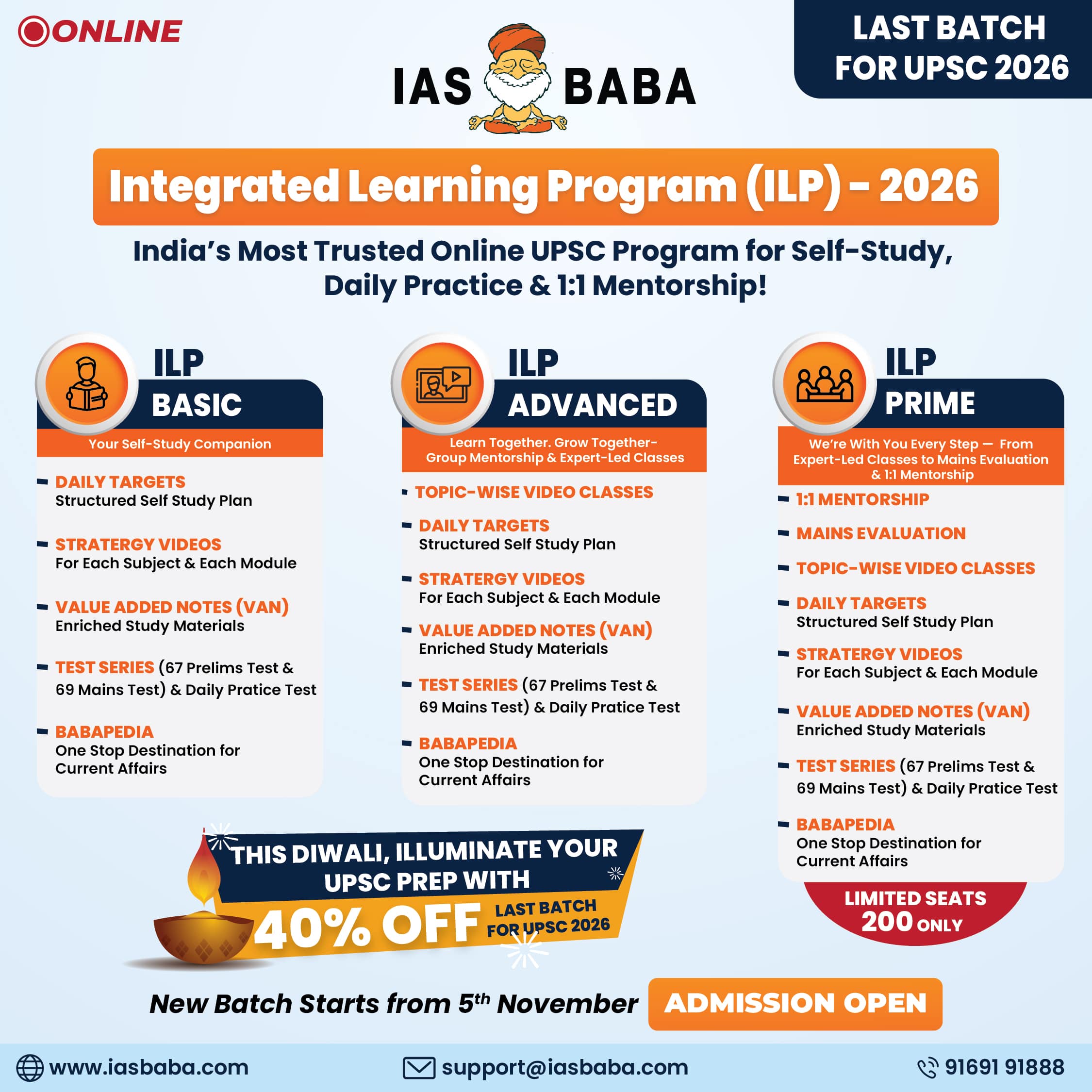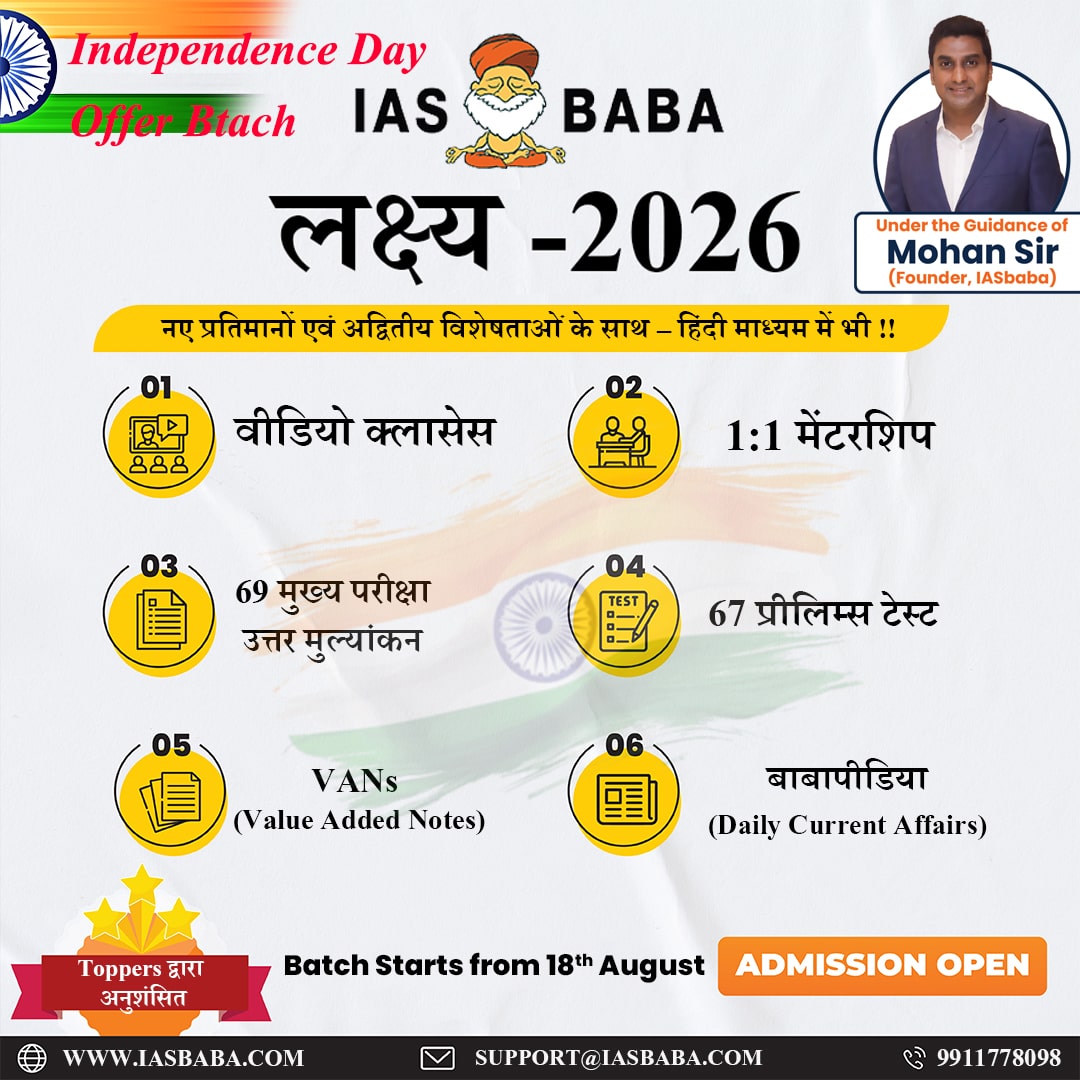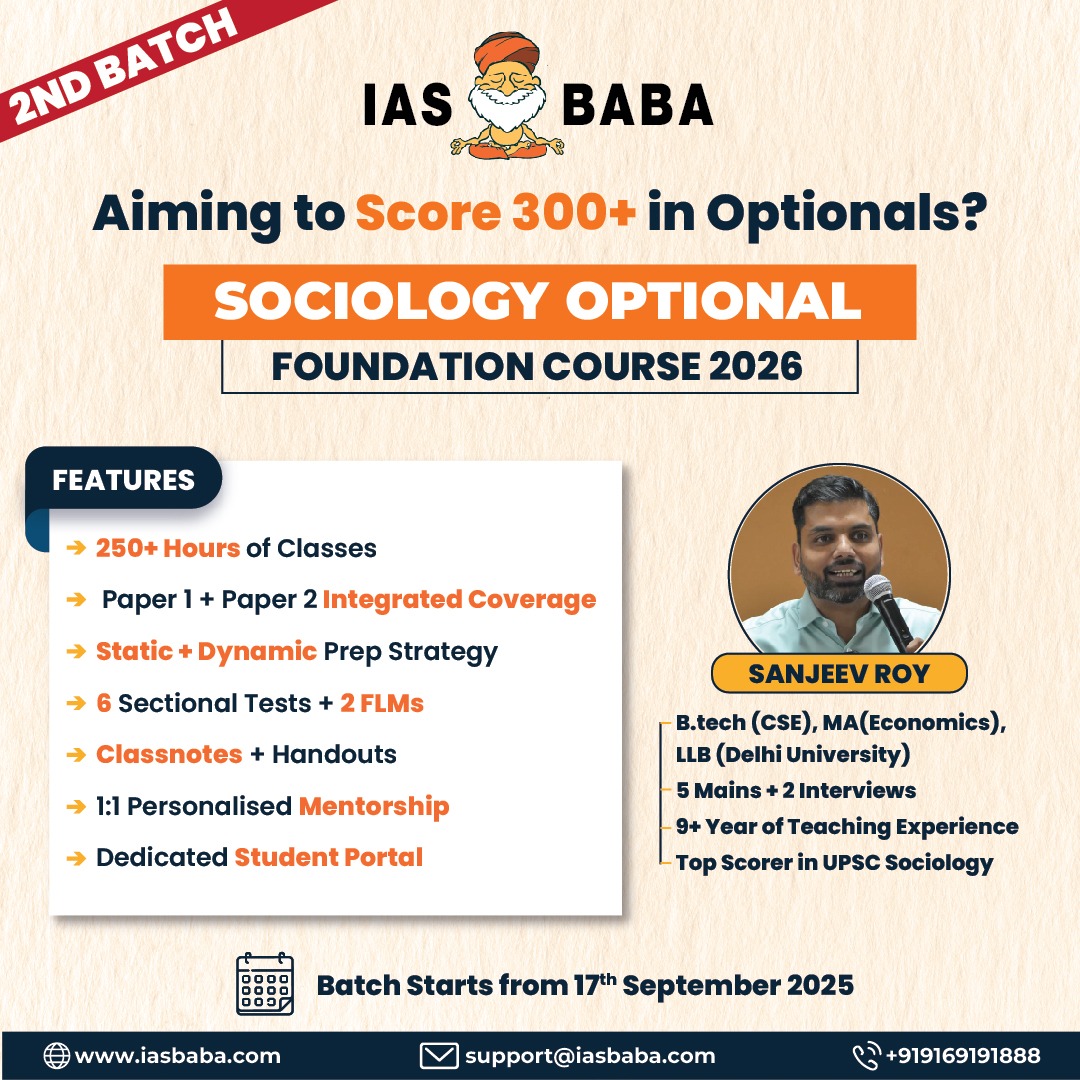IASbaba's Daily Current Affairs Analysis
Archives
(PRELIMS Focus)
Category: ENVIRONMENT
Context: India is actively moving toward ratification of the High Seas Treaty (formally the Biodiversity Beyond National Jurisdiction – BBNJ – Agreement), contrary to any suggestion of reluctance.
Decoding Context:
Key Highlights:
- India has signed the BBNJ Treaty and is undergoing its internal ratification process.
- At the 2025 UN Ocean Conference in Nice, the Minister of State for Earth Sciences confirmed India’s commitment to the treaty and ocean conservation.
- A six-point action plan was proposed by India, focusing on science-based, inclusive, and sustainable ocean governance.
India’s Commitments:
- Enhancing marine research and data-driven ocean policy.
- Expanding marine protected areas.
- Tackling plastic and marine pollution via circular economy models.
- Promoting climate resilience and ocean-based solutions.
- Supporting renewable ocean energy.
- Integrating indigenous knowledge in marine governance.
India also endorsed the ‘Nice Ocean Action Plan’, emphasizing finance, partnerships, and actionable steps toward achieving SDG-14 (Life Below Water).
Global Status:
- As of mid-2025, 49 countries have ratified the treaty; 60 ratifications are required for it to come into force.
- The treaty aims to:
- Protect biodiversity in international waters.
- Establish marine protected areas.
- Ensure fair sharing of marine genetic resources.
- Foster international cooperation for high seas governance.
Conclusion:
India is firmly aligned with the objectives of the High Seas Treaty and is progressing toward formal ratification. Its current stance reflects a deliberate, policy-driven approach consistent with its broader marine conservation strategy.
Learning Corner:
High Seas Treaty (BBNJ Agreement)
Full Name: Agreement on Biodiversity Beyond National Jurisdiction (BBNJ)
Adopted: June 2023 at the United Nations
Purpose:
To conserve and sustainably use marine biological diversity in areas beyond national jurisdiction (ABNJ), i.e., the high seas which cover nearly two-thirds of the ocean and nearly half of the Earth’s surface.
Key Features:
- Marine Protected Areas (MPAs): Establish a global framework to create protected zones in international waters to safeguard marine ecosystems.
- Marine Genetic Resources (MGRs): Ensure fair and equitable sharing of benefits arising from the utilization of MGRs, such as deep-sea organisms used in pharmaceuticals or biotechnology.
- Environmental Impact Assessments (EIAs): Mandates EIAs for activities conducted on the high seas to prevent significant harm to marine environments.
- Capacity Building and Technology Transfer: Assists developing countries with scientific resources, training, and data-sharing to ensure equitable participation in high seas conservation.
- Decision-Making Structure: Establishes institutions to monitor implementation, resolve disputes, and update scientific guidelines periodically.
Significance:
- Fills a major legal gap in international maritime law under the UNCLOS (United Nations Convention on the Law of the Sea).
- Aims to protect biodiversity in the “global commons”.
- Critical for tackling threats such as overfishing, climate change, and deep-sea mining.
Global Treaties that India has ratified and not ratified:
| Category | Ratified by India | Not Ratified by India |
|---|---|---|
| Nuclear Treaties | CWC, BWC | NPT, CTBT, ATT |
| Environmental Treaties | UNFCCC, CBD, Paris Agreement, Basel, Stockholm | BBNJ (in process), some UN water conventions |
| Human Rights Treaties | ICCPR, ICESCR, CRC, CEDAW | Migrant Workers’ Convention, Enforced Disappearances |
| Labour Treaties | Some ILO conventions | ILO 87, 98, partially delayed ratification of 138 |
| Maritime Treaties | UNCLOS, CITES, WTO-related | None major |
Source : THE HINDU
Category: HISTORY
- Sankaran Nair’s legacy defies simple categorization due to his multifaceted roles as a jurist, nationalist, reformer, and critic. He was both an insider in the British legal system and a principled dissenter, resigning from the Viceroy’s Council after the Jallianwala Bagh massacre.
Key Aspects of His Legacy
- Constitutionalist and Rebel: Rose to become a judge of the Madras High Court, yet protested British atrocities and advocated for Indian rights through constitutional means.
- Legal and Social Reformer: Delivered landmark judgments emphasizing due process and justice. Advocated inter-caste marriage, women’s rights, and eradication of caste discrimination.
- Independent Nationalist: Supported Dominion Status as a step toward full independence. Criticized both British colonialism and Indian political orthodoxy, especially Gandhi’s mass movements and the Khilafat agitation.
- Courage and Integrity: Refused to apologize after losing a defamation case in England. Resigned from high office over ethical concerns.
- Underappreciated Figure: Despite his influence, his contributions were sidelined in mainstream narratives. He is now being rediscovered through biographies and popular media.
Conclusion
Sankaran Nair’s life embodied contradiction and courage—an elite fighting for the marginalized, a loyal servant of law who challenged empire, and a moderate voice amid radical upheaval. His legacy is essential to understanding the complexities of India’s freedom struggle.
Learning Corner:
- Sankaran Nair (1857–1934)
Lawyer | Jurist | Nationalist | Social Reformer
- Sankaran Nair was a prominent Indian jurist and nationalist leader known for his bold dissent against British colonial rule and his deep commitment to constitutionalism and social justice.
- He served as the President of the Indian National Congress in 1897, becoming the first Malayali to hold the position.
- Appointed Advocate-General of Madras and later a Judge of the Madras High Court, he was known for his commitment to legal integrity and civil rights.
- In protest against the Jallianwala Bagh massacre (1919), he resigned from the Viceroy’s Executive Council, becoming one of the earliest high-ranking Indians to do so.
- Nair was a strong advocate for social reform, promoting women’s rights, caste equality, and inter-caste marriage.
- He opposed Gandhi’s methods of mass civil disobedience and criticized the Khilafat Movement, preferring constitutional and legislative paths to reform.
- His book, Gandhi and Anarchy, outlined his differences with the dominant nationalist strategies of his time.
- Despite his contributions, he was largely forgotten in mainstream history until recent efforts began reviving interest in his legacy.
Source: THE HINDU
Category: INTERNATIONAL
Context : Egypt’s Crackdown Forces Sudanese Refugees Toward Libya and Europe
Decoding Context:
Following the 2023 civil war in Sudan, millions fled the country—many initially seeking safety in Egypt due to its proximity and historic ties. However, Egypt’s increasingly restrictive refugee policies have made it harder for Sudanese to remain. Stricter visa rules, costly residency requirements, and a shift from UNHCR to government-controlled refugee registration have led to widespread detentions and deportations, even for registered asylum seekers.
Facing harassment, fear of arrest, and poor living conditions, many Sudanese are now fleeing from Egypt through Libya in hopes of reaching Europe. Libya, though deeply unstable, has become a major transit route despite being extremely dangerous. Refugees face abuse, extortion, sexual violence, and repeated detentions by militias and smugglers. Women and children are especially vulnerable, and many endure brutal treatment before attempting perilous sea crossings to Europe.
The humanitarian response is overwhelmed, with aid agencies warning of dire shortages and funding gaps as refugee numbers climb. Meanwhile, rights groups argue Egypt’s actions violate international obligations, and concerns have been raised over European complicity in funding Egypt’s border control efforts.
Learning Corner:
Sudan War
The Sudan War that began in April 2023 is a devastating internal armed conflict between two powerful military factions in Sudan:
Key Actors:
- Sudanese Armed Forces (SAF): Led by General Abdel Fattah al-Burhan, the de facto head of state.
- Rapid Support Forces (RSF): A powerful paramilitary group led by Mohamed Hamdan Dagalo (also known as “Hemedti”), originally formed from the Janjaweed militias of Darfur.
Cause of the Conflict:
- The war erupted due to a power struggle between the SAF and RSF, who were supposed to integrate under a new civilian-led transitional government following the ousting of dictator Omar al-Bashir in 2019.
- Disagreements over security sector reform, power-sharing, and political timelines led to open conflict.
Consequences:
Humanitarian Catastrophe:
- Over 9 million people displaced (internally and abroad), including to Egypt, Chad, and South Sudan.
- Widespread famine-like conditions, ethnic violence, and civilian massacres, especially in Darfur.
Health and Infrastructure Collapse:
- Hospitals destroyed or shut.
- Access to food, water, and medicine severely limited.
Regional Destabilization:
- Flow of refugees into neighbouring countries.
- Potential for spillover effects and broader destabilization of the Horn of Africa.
Global Response:
- UN, AU, Arab League, and Western countries have condemned the violence, but ceasefires have repeatedly broken down.
- Peace talks mediated by Saudi Arabia, USA, and African Union have made limited progress.
Current Status (as of 2025):
- The war continues with no stable government, deepening lawlessness, ethnic cleansing, and potential signs of state collapse.
Source : THE HINDU
Category: POLITY
Context : On June 12, 1975, the Allahabad High Court found Prime Minister Indira Gandhi guilty of electoral malpractice for misusing government resources during her 1971 election campaign.
Decoding Context
The court declared her election to the Lok Sabha invalid and barred her from holding elected office for six years. This judgment posed a serious threat to her political future and triggered a major constitutional crisis.
Gandhi’s Response and the Emergency
Instead of resigning, Indira Gandhi appealed to the Supreme Court, which granted a conditional stay allowing her to remain Prime Minister but barred her from voting as an MP. As public protests grew and opposition intensified, she advised the President to declare a national Emergency on June 25, 1975, under Article 352 of the Constitution.
The Emergency led to the suspension of civil liberties, press censorship, and the arrest of thousands of opposition leaders and activists. The government acquired sweeping powers and curtailed judicial independence.
Aftermath and Legacy
The Emergency lasted 21 months and ended in March 1977. It is remembered as a dark chapter marked by authoritarian rule, forced sterilizations, suppression of dissent, and democratic backsliding. Constitutional amendments during this time further shielded the Prime Minister from legal scrutiny.
Learning Corner:
Brief Note on Emergency Provisions in the Indian Constitution
The Emergency provisions in the Indian Constitution allow the central government to assume greater powers to deal with extraordinary situations that threaten the security, unity, or integrity of the nation. These are covered under Part XVIII (Articles 352 to 360).
Types of Emergencies:
- National Emergency – Article 352
-
-
- Grounds: War, external aggression, or armed rebellion.
- Effect:
- Federal structure becomes unitary.
- Fundamental Rights under Article 19 suspended.
- Parliament can legislate on State subjects.
- Life of Lok Sabha and State Assemblies can be extended.
- Example: Imposed thrice — 1962 (China War), 1971 (Pakistan War), 1975 (Internal disturbance during Indira Gandhi’s rule).
-
- President’s Rule (State Emergency) – Article 356
-
-
- Grounds: Failure of constitutional machinery in a state.
- Effect:
- State government is dismissed.
- President governs the state through Governor.
- Parliament makes laws for the state.
- Duration: Initially 6 months; extendable up to 3 years with Parliamentary approval.
- Example: Imposed over 100 times in various states.
-
- Financial Emergency – Article 360
-
- Grounds: Threat to the financial stability or credit of India or any part of its territory.
- Effect:
- Salaries and allowances of government employees can be reduced.
- Money bills of states require Presidential approval.
- Note: Never invoked in Indian history.
Key Safeguards (Post 44th Amendment, 1978):
- National Emergency must be approved by Parliament within 1 month (earlier 2 months).
- Extension requires every 6 months approval.
- Fundamental Rights under Articles 20 and 21 cannot be suspended even during Emergency.
- For declaring Emergency, written advice of the Cabinet is mandatory.
Important Case laws:
| Case | Year | Key Issue | Outcome |
|---|---|---|---|
| A.K. Gopalan v. State of Madras | 1950 | Preventive detention legality | Validated; Fundamental Rights seen in isolation |
| ADM Jabalpur v. Shivkant Shukla | 1976 | Right to life during Emergency | Denied; overruled later |
| Minerva Mills v. Union of India | 1980 | Limits on amending power during Emergency | Asserted Basic Structure doctrine |
| Kesavananda Bharati v. State of Kerala | 1973 | Scope of constitutional amendments | Basic Structure doctrine established |
| Waman Rao v. Union of India | 1981 | Post-Emergency judicial review | Affirmed Basic Structure and limits on Parliament’s power |
Source: THE INDIAN EXPRESS
Category: ECONOMICS
Context : India’s CPI Inflation Falls Below 3% in May 2025 — First Time in 6 Years
Decoding Context:
India’s Consumer Price Index (CPI) inflation for May 2025 is estimated to have dropped below 3%, the lowest since April 2019. Projections suggest it may be around 2.7%, following April’s already low 3.16%.
Key Drivers of the Decline
- Easing food prices: Despite some increases in vegetable prices, the fall in cereals and pulses helped push overall food inflation down.
- Favorable year-on-year base effect: Essential commodities recorded their first annual price decline since early 2019.
- Core inflation: Remained moderate at ~4.2% due to weak domestic demand and soft global commodity prices.
Policy and Economic Implications
- This decline may prompt the RBI to shift its stance from accommodative to neutral, though further rate cuts are unlikely in the near term.
- The RBI has revised its FY26 inflation forecast down to 3.7%, reflecting confidence in continued price stability.
Learning Corner:
Types of Inflation – Based on Causes
- Demand-Pull Inflation
- Occurs when aggregate demand exceeds aggregate supply.
- Common in rapidly growing economies.
- E.g., excessive consumer spending, rise in government expenditure.
- Cost-Push Inflation
- Arises due to increase in production costs (raw materials, wages, etc.).
- Producers pass increased costs to consumers.
- E.g., oil price shocks, wage hikes.
- Built-in Inflation (Wage-Price Spiral)
- Inflation that results from feedback loops between wages and prices.
- Higher wages → increased costs → higher prices → demand for more wages.
Types of Inflation – Based on Rate of Increase
| Type | Inflation Rate (approx.) | Nature/Impact |
|---|---|---|
| Creeping/Mild | < 3% | Slow and manageable; often considered healthy. |
| Walking | 3–10% | Noticeable rise in prices; may need policy action. |
| Running | 10–20% | Hurts purchasing power significantly. |
| Galloping | > 20% | Very high and dangerous; affects economic stability. |
| Hyperinflation | > 100% | Prices rise uncontrollably (e.g., Zimbabwe, 2008). |
Types of Inflation – Based on Scope
- Headline Inflation
- Measures total inflation including volatile items like food and fuel.
- Indicator used in CPI (Consumer Price Index).
- Core Inflation
- Excludes food and fuel prices.
- Indicates underlying inflationary pressures.
Other Forms of Inflation
- Stagflation
- High inflation + stagnant growth + high unemployment.
- Very difficult to control via traditional policies.
- Deflation
- Negative inflation; general fall in prices.
- May lead to lower production and unemployment.
- Disinflation
- A fall in the rate of inflation (e.g., from 6% to 3%).
- Prices are still rising, but at a slower rate.
Source : THE INDIAN EXPRESS
(MAINS Focus)
Introduction (Context)
June 12 is observed globally as the World Day Against Child Labour (WDACL) by the International Labour Organization (ILO) to bring attention to the persistent issue of child labour and brings together governments, employers and workers’ organisations as well as civil society to work towards ending child labour.
However, child labour is prevalent all over the world and we are far from achieving Sustainable Development Goal Target 8.7 that calls on the global community to take effective measures to end child labour in all its forms by 2025.
The Velpur Mandal of Telangana presents a rare, replicable model of eliminating child labour through a community-driven movement.
What is Child Labour?
Child labour refers to the exploitation of children through any form of work that deprives them of their childhood, interferes with their education, and is harmful to their physical and mental development. It is distinct from permissible light work done in safe environments and outside school hours.
Status and Trends
- Global scenario:
- 160 million children are estimated to be involved in child labour which is almost one among 10 children.
- The Africa, Asia and the Pacific regions together account for almost nine out of every 10 children being in child labour.
- The COVID-19 pandemic exacerbated the situation for many underprivileged children, when their schools closed, and their parents lost their jobs/wages. Many children who dropped out of school, and who were forced to work to supplement their family income, have not returned to school.
- India:
- Census 2011: 43.53 lakh children (5–14 age group) engaged in child labour.
- Prevalent in beedi units, carpet weaving, fireworks, and agriculture sectors.
Causes of Child Labour
- Poverty and indebtedness
- Lack of access to quality education
- Cultural acceptance of child work in informal sectors
- Weak enforcement of labour and education laws
- Migration and displacement
Impact of Child Labour
- Denial of education and skill development
- Physical and psychological exploitation
- Intergenerational poverty
- Violation of fundamental rights and human dignity
Constitutional and Legal Provisions
- Article 21A: Right to free and compulsory education (6–14 years)
- Article 24: Prohibits employment of children below 14 in hazardous industries
- Right to Equality and Protection against Exploitation
Government Initiatives
Child Labour (Prohibition and Regulation) Act, 1986 (Amended in 2016):
- Prohibits employment of children below 14 years in any occupation or process.
- Restricts adolescents (14–18 years) from working in hazardous occupations listed in the schedule.
- Prescribes penalties for employers violating the law and includes provisions for rehabilitation of rescued children.
National Policy on Child Labour, 1987:
- Emphasizes a gradual and sequential approach to eliminate child labour.
- Focuses on rehabilitating children rather than punitive action.
- Targets high-incidence areas through developmental interventions.
National Child Labour Project (NCLP):
- Rescued children are placed in special schools/bridge schools.
- Provides education, vocational training, stipends, mid-day meals, and healthcare.
- Implemented in districts with high child labour prevalence.
PENCIL Portal (Platform for Effective Enforcement for No Child Labour):
- Serves as a centralised online portal to register complaints and track child labour cases.
- Facilitates coordination among district authorities, labour departments, and law enforcement.
- Monitors real-time implementation of NCLP and rehabilitation efforts.
Mid-Day Meal Scheme, Samagra Shiksha Abhiyan, and PM Poshan:
- Provide nutritional meals, textbooks, and incentives to retain children in school.
- Address dropout rates and reduce the economic burden on poor families.
- Promote universal access to elementary education and discourage child labour.
Right to Education Act (RTE), 2009:
- Makes free and compulsory education a legal right for all children aged 6–14.
- Prohibits any form of child labour interfering with school attendance.
Challenges in Eradicating Child Labour in India
- Hidden nature of child labour in informal sectors
- Poor rehabilitation of rescued children
- Family economic compulsions and social tolerance
- Lack of sustained local-level monitoring
- Ineffective grievance redressal and coordination among agencies
Case Study: The Velpur Model (Telangana)
- In Velpur Mandal (tehsil) of Nizamabad district in erstwhile Andhra Pradesh (now Telangana), child labour was prevalent in high numbers.
- In June 2001, a drive involving the community was started in Velpur to ensure that all children in the age group of five to 15 years went to school and that no child would be engaged as labour in any form.
- After a sustained campaign for about 100 days, Velpur was declared to be a “child labour free mandal”, on October 2, 2001. Twenty-four years later, there is 100% retention in schools and no child labour in a mandal once notorious for it.
Steps taken:
- The campaign to identify and track every out-of-school child and enrol them in schools.
- Children who were seen in work places were sent to bridge schools under the NCLP. (Bridge schools offer bridge education, vocational training, and support services like mid-day meals and stipends to help children catch up academically and prepare them for mainstream schooling)
- Public meetings emphasised the necessity of education and the need for children to go to school. In these meetings, children recognised their (former) employers who let them stop work and go to school. Under peer pressure, former employers also made a public announcement of writing off the balance amount (principal, the interest and penal interest) owed to them by the parents who took hand loans from them (the children were used as mortgage and as child labour till the amount was repaid). They even distributed school stationery to the children.
- All sarpanchs signed a memorandum of understanding (as in the provisions of the Andhra Pradesh Compulsory Primary Education Rules, 1982), with the government (district education officer in the presence of the District Collector) to ensure that all children in the five to 14 age group in their village were sent to school. The government in turn undertook to provide access, infrastructure and teachers
Recognitions:
- Celebrated under Azadi Ka Amrit Mahotsav (2021) by VV Giri National Labour Institute
- Acknowledged by ILO, President APJ Abdul Kalam, NHRC, and Parliamentary Standing Committee (2022)
- Incorporated into VVGNLI training modules as a replicable model
Way Forward
- Universal access to education and strengthening of RTE enforcement
- Livelihood support to families through MGNREGA, SHGs, etc.
- Convergence between labour, education, and rural development departments
- Replication of community-based models like Velpur
- Strengthen monitoring mechanisms through PENCIL Portal and local task forces
- Conduct periodic social audits and child tracking surveys
Mains Practice Question
Q “Despite various legislations and policies, child labour continues to be a harsh reality in India.” Examine the causes and suggest sustainable community-led solutions. (250 words, 15 marks)
Introduction (Context)
- Recently, government has declared that it would end Naxalism by 31 March 2026 and also urged Naxal-affected states to expedite local infrastructure development programmes and provide the best possible rehabilitation packages to surrendered Naxals, while simultaneously continuing operations.
- In this context, the Gadchiroli model of combining CFR recognition, infrastructure development, and community empowerment offers valuable lessons for other Naxal-affected districts..
About Naxalism
- Naxalism refers to the armed communist insurgency originating from the village of Naxalbari in West Bengal (1967).
- It is inspired by Maoist ideology, aiming to overthrow the government through armed struggle, especially in rural and tribal areas.
Causes
- Land Alienation: Tribal farmers lost land without fair compensation.
- Forest Resource Exploitation: Conservation and industrial projects displaced forest communities.
- Poverty and Unemployment: Underdevelopment made tribal youth vulnerable to recruitment.
- Social Exclusion: SCs and STs faced systemic neglect and discrimination.
- State Repression: Police excesses triggered resentment among tribal populations.
- Political Marginalisation: Tribals lacked voice in governance and decision-making.
Impact of Naxalism
- Security Threat: Disturbs internal security in several regions.
- Loss of Life and Property: Frequent violence against civilians and security forces.
- Development Obstruction: Halts infrastructure and welfare initiatives.
- Human Rights Violations: Atrocities by both extremists and state agencies.
- Democratic Erosion: Undermines state authority and democratic functioning.
Case study: Gadchiroli Model
- Gadchiroli is a district in Maharashtra, known for its vast forests, rich tribal culture, and natural beauty.
- It is a part of red corridor. (“Red corridor” refers to the region in India where the Naxalite-Maoist insurgency has the strongest influence. The term “red corridor” refers to the region in India where the Naxalite-Maoist insurgency has the strongest influence.)
- Steps by district to combat naxalism:
- Development of infrastructure
- Rehabilitation packages to surrendered Naxals It’s
- Recognize customary and traditional rights of forest-dwelling communities over forest resources.
Key Features of the Gadchiroli Model
- Of the 9,902.8 sq km forest in Gadchiroli, 5,110.07 sq km is under community control, the highest in India.
- 1,109 villages enjoy legal CFR recognition under the Forest Rights Act, 2006.
- In 2009, Mendha Lekha became the first village in India to be granted CFR.
- Provides exclusive rights over minor forest produce (MFP) such as bamboo and tendu.
- Gram Sabhas manage forest rights and resources democratically.
- Maharashtra allowed Gram Sabhas to issue bamboo transit passes.
- The government provided financial incentives (e.g., ₹1.78 lakh per CFR village).
- Governor’s directives empowered Scheduled Areas under the Fifth Schedule to auction and sell MFP.
- MoU with 728 Gram Sabhas for technical and financial support to implement CFR activities at the local level.
What are Community Forest Rights?
Community Forest Rights (CFRs) are legal rights granted to forest-dwelling communities under the Forest Rights Act (FRA), 2006 in India. These rights recognize the traditional and customary ownership, use, and management of forest resources by communities.
Key Features of CFRs
- Rights are vested in the entire community or Gram Sabha, not individuals.
- Communities have the right to collect, use, and dispose of minor forest produce (like bamboo, tendu leaves, honey, etc.).
- Communities are empowered to conserve, regenerate, and manage forest resources sustainably.
- Recognizes rights over forests used for cultural, religious, and livelihood purposes.
- The Gram Sabha is the decision-making body for forest management and benefit-sharing.
- Strengthens democratic decentralisation in Scheduled Areas.
- Promotes sustainable forest conservation through local stewardship
Achievements in Gadchiroli district
- Livelihood Security: CFR households earn a minimum ₹7,000/month from forest-based income.
- Environmental Sustainability: Forests managed by Gram Sabhas show lower deforestation than those under forest departments.
- Decentralised Governance: Transparent decision-making via Gram Sabha mechanisms.
- Economic Upliftment: Reduced migration, fewer middlemen, increased investment in education and health.
- Reinvestment in Forest Conservation: Local patrols, plantation drives, and forest protection initiatives led by communities.
Reasons for Success
- Collective action and grassroots movements initiated by local tribal leaders. They did not depend on external agencies or NGOs for their forest rights.
- The District Collector’s office has initiated a series of activities, making policies at the Gram Sabha level more responsive to sustainable tribal livelihood and forest conservation. To date, the administration has signed a memorandum of understanding (MoU) with 728 Gram Sabhas to provide necessary technical and financial support in the development, management, and implementation of the recognised CFR areas.
Challenges
- Mining Threats: Fear of displacement due to proposed steel plants and mining projects, especially in South Gadchiroli.
- Implementation Gaps: Need for better convergence of development schemes at district and block levels.
- Rights Protection: Government must ensure development does not violate PESA and FRA safeguards.
Value Addition
Forest Rights Act (FRA), 2006
- Its objective is to recognize and vest forest rights in forest-dwelling Scheduled Tribes and other traditional forest dwellers.
- Key Provisions:
- Individual Rights: For habitation and cultivation on forest land (up to 4 hectares).
- Community Forest Rights (CFRs): To manage and use forest produce collectively.
- Recognition of Rights: Based on customary use, irrespective of forest classification.
- Gram Sabha Role: Central in identifying beneficiaries and managing forest rights.
- Significance:
- Legal empowerment of tribal communities.
- Livelihood security and forest conservation.
- Reduction in alienation and forest-related conflicts.
Panchayats (Extension to Scheduled Areas) Act – PESA, 1996
- Its objective is to extend Part IX of the Constitution (Panchayati Raj) to Fifth Schedule areas with tribal populations.
- Key Provisions:
- Empowers Gram Sabhas to manage natural resources, approve development plans, and protect tribal culture.
- Gram Sabhas must be consulted before land acquisition and rehabilitation.
- Control over local markets, minor water bodies, and minor forest produce.
- Significance:
- Ensures self-governance for tribal communities.
- Strengthens decentralised democracy in tribal areas.
- Safeguards against exploitation and displacement.
Way Forward
- Replicate the Gadchiroli Model in other LWE-affected regions through:
- Strong administrative will for decentralisation.
- Institutional and financial support to Gram Sabhas.
- Protection of forest rights against commercial exploitation.
- Ensure tribal autonomy and livelihood security remain central to development planning in Scheduled Areas.
Mains Practice Question
Q “Recognition of Community Forest Rights can be a sustainable pathway to tackle Naxalism.” Analyse in the context of Gadchiroli’s experience and suggest how this model can be replicated in other Naxal-affected areas. (250 words, 15 marks)
Daily Practice MCQs
Today’s – Daily Practice MCQs’ will be updated in our “Daily Current Affairs Quiz” section on our website
Please click on the below link













